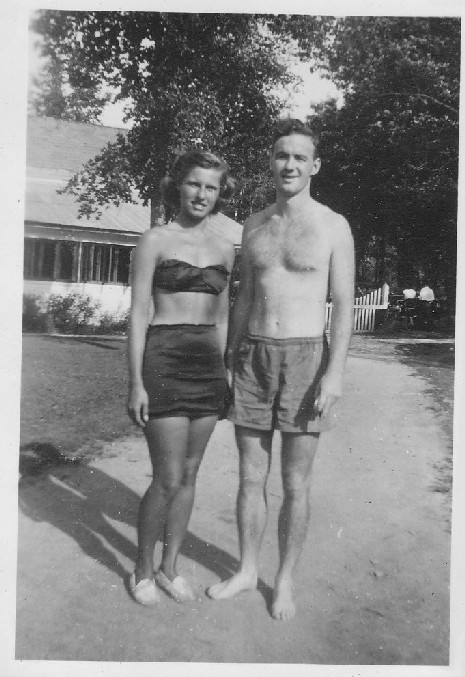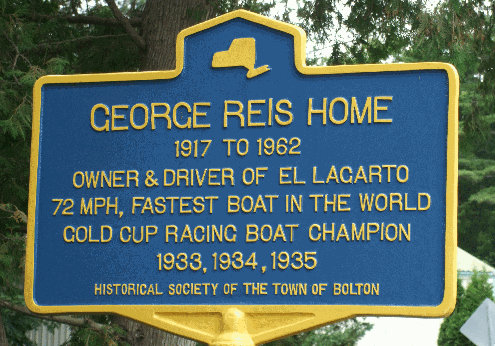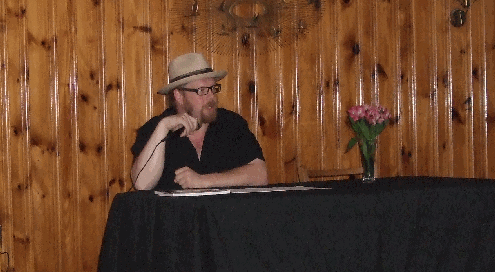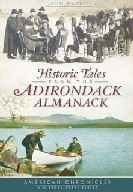
The text is a bit hard to read from this flyer but the movie, Gun Glory, was showing at “Movie Night at Huletts” on Tuesday, August 30, 1960.
Hulett’s Casino – 9:30 P.M.
Children Under 12 – $.50
Adults – $.60

News & Opinion About Huletts Landing, N.Y.

The text is a bit hard to read from this flyer but the movie, Gun Glory, was showing at “Movie Night at Huletts” on Tuesday, August 30, 1960.
Hulett’s Casino – 9:30 P.M.
Children Under 12 – $.50
Adults – $.60

Two hotel guests stand next to the original Casino in 1947.
Columbus Before the Queen – Emanuel Gottlieb Leutze – 1843
Click the Image to See Full Scale
October 12, 1492
“On the thirty-fifth day of the voyage, two hours after midnight, a sailor on the Pinta shouted “Land!” He could see land by the light of the moon. That morning, October 12, 1492 all the men went ashore. The place? Guanahaní, an island in the Bahamas, renamed San Salvador.”
“Called Guanahani by the native Lucayan Indians, Columbus renamed the island San Salvador or “Holy Saviour,” noting in his journal: “The beauty of these islands surpasses that of any other and as much as the day surpasses the night in splendour.””
I came across this old picture of some folks enjoying the soda fountain. My guess is that it is from approximately 1960.

If you know any of the people in the photo, please let me know.
Giants Break Camp in Albany, Perhaps for Good
The Times Union takes a look at the Giant’s recently completed training camp and if they’ll return next year.
Bike Trip Around Lake George
The Warren Pieces blog tells about a planned bike ride around the entire lake.
People Coming Upstate to Vote
WNBZ has a story about people who live downstate, coming upstate to vote.
Diving Deep for Art
The Post Star takes a look at a new exhibition, which runs through Sept. 10 at the Lake George Arts Project Courthouse Gallery, that “combines art and science to study how testate amoebae living at the bottom of Lake George have interacted for centuries with the submerged remnants of the “Sunken Fleet of 1758.”
National Geographic has a neat video which recreates what Henry Hudson saw when he landed on Manhattan Island in 1609. Take a look.
httpv://www.youtube.com/watch?v=pKh91QWxB8k
This is a newly restored high definition picture of Abraham Lincoln shortly before he was assassinated. Click on the “full size” link below the picture. This is truly remarkable. The suffering that he had to deal with is fully evident in his eyes and he certainly looks tired. It’s also interesting because people think of him as dark-skinned, and thus dark-eyed. His contemporaries, however, always remarked upon his “grey” eyes. You can clearly see that in this picture. Fascinating. Check it out.

George Reis tested his boat, El Lagarto, (The Lizard) in Lake George before winning the Gold Cup for three consecutive years in the 1930’s. A sign marks the spot where he lived, on the road that leads to the Sagamore resort.
The Gold Cup is the oldest active trophy in all of motorboat racing. Bolton Landing resident, George Reis, would capture the Gold Cup in 1933, 1934, and 1935 in a boat he tested on Lake George. The Lizard flew by Huletts Landing while it was being tested, in route to trouncing the competition in those years.
In another little known fact about the Gold Cup, boat designer Christopher Columbus Smith (of the Chris Craft boat company) captured the Gold Cup in 1915 in a boat that topped the elusive 60 miles-per-hour speed barrier.
This is a really cool painting entitled “Life and Death” by artist Robert Griffing. These two Indian warriors are scouting Lake George. The Iroquois and Algonquin tribes competed viciously in this area and this picture caught my attention.
I’ll be doing more on the Indians this winter but this painting really captures what they must have looked like. I wouldn’t want to run into these dudes walking through the woods.
With tonight being your last chance to see the Perseid meteor shower at its peak, I found this high quality video about the Hubble Space telescope to be quite fascinating.
It focuses on (no pun intended) the view into empty black sky that turned out to be full of thousands and thousands of galaxies. This area know as the ultra deep field, is our view back in time to the beginning of the universe.
After watching this, you won’t look up into the night sky the same way again.
httpv://www.youtube.com/watch?v=oAVjF_7ensg

John Warren, publisher of the Adirondack Almanack blog, and author of the new book entitled; Historic Tales from the Adirondack Almanack, enlightened the Casino audience on Saturday night with stories about early Huletts life and local history.
If you missed John Warren’s lecture on Saturday night, you missed a good one. John’s talk started with blogging and new media but covered a variety of local history.

He passed on to me a variety of topics for future posts. Topics discussed ranged from the Belden, Burgess and Huletts families, the Millerites, Benson VT where numerous Huletts also settled, Mormon history, and religious intrigue from the mid-1800’s.
I would highly recommend his new book entitled; Historic Tales from the Adirondack Almanack (published by The History Press).
Thanks John for spending the time with us in the Huletts Casino!
I’m pleased to announce that John Warren, publisher of the Adirondack Almanack blog, has agreed to give a lecture at the Huletts Casino on this Saturday, August 8th at 7:30 p.m. about blogging in the Adirondacks and his new book. John has a special personal connection to the Hulett family whom Huletts Landing is named after so we’re quite honored to have him speak.
His talk is entitled;
Adirondack Almanack: Adirondack Blogs, Books, and History
The Adirondack Almanack is the most widely read and most respected blog in the Adirondacks and John has been blogging for a number of years.

He has also recently released a new book entitled; Historic Tales from the Adirondack Almanack (published by The History Press). It’s a compilation of history essays from the last four years of the Almanack and it’s the Adirondack region’s first blog-to-book.
John is a writer, historian, educator, and filmmaker. He has produced and directed prizewinning film and video crews around the world and holds credits on more than 100 hours of primetime television. John’s work has appeared in a variety of media from PBS, History Channel, and Discovery to Adirondack Life, numerous regional and local newspapers, and online. John has lectured on history, writing, journalism, and documentary production at nearly a dozen colleges and universities and has taught at Ithaca College, SUNY Albany, and Adirondack Community College.
There is no charge for the lecture. It will begin at 7:30 pm. If you want to come early and purchase dinner that’s OK too! It’s sure to be an interesting talk.
Here is a link to John’s post on his blog about the lecture.
The next time you’re heading to Whitehall, on the top of the mountain before you start down the other side, you can see this marker through the woods on the right hand side.

What is this? Well next time don’t drive by so fast. It marks a very historic spot.
It is actually a monument that the Town of Dresden erected in 1976 to desiginate the historic march through the woods that happened there in 1776. Here is a close up shot of the monument itself. It looks as new today as the day it was first put there.

This is the story behind it. (Condensed from online sources.)
In 1776-77 General John Burgoyne was given command of the British forces charged with gaining control of Lake Champlain and the Hudson River valley. The plan, largely of his own creation, was for Burgoyne and his force to cross Lake Champlain from Quebec and capture Ticonderoga before advancing on Albany, New York, where they would rendezvous with another British army under General Howe coming north from New York City, and a smaller force that would come down the Mohawk River valley under Barry St. Leger. This would divide New England from the southern colonies, and, it was believed, make it easier to end the colonies rebellion.
From the beginning Burgoyne was vastly overconfident. Leading what he believed was an overwhelming force, he saw the campaign largely as a stroll that would make him a national hero who had saved the rebel colonies for the crown. Before leaving London he had wagered a friend ten pounds that he would return victorious within a year. He refused to heed more cautious voices, both British and American, that suggested a successful campaign using the route he proposed was impossible.
Underlining the plan was the belief that Burgoyne’s aggressive thrust from Quebec would be aided by the movements of two other large British forces under General Howe and Sir Henry Clinton who would support the advance. However, Lord Germain’s orders dispatched from London were not clear on this point, with the effect that Howe took no action to support Burgoyne, and Clinton moved from New York too late and in too little strength to be any great help to Burgoyne.
As a result of this miscommunication, Burgoyne ended up conducting the campaign largely single-handedly. Even though he was not aware of this yet, he was still reasonably confident of success. Having amassed an army of over 7,000 troops in Quebec, Burgoyne was also led to believe by reports that he could rely on the support of large numbers of Native Americans and American Loyalists who would rally to the flag once the British came south. Even if the countryside was not as pro-British as expected, much of the area between Lake Champlain and Albany was underpopulated anyway, and Burgoyne was skeptical any major enemy force could gather there.
The campaign was initially successful. Burgoyne gained possession of the vital outposts of Fort Ticonderoga (for which he was made a lieutenant-general) and Fort Edward, but, pushing on, was detached from his communications with Quebec, and eventually hemmed in by a superior force, led by Horatio Gates. Several attempts to break through the enemy lines were repulsed at Saratoga in September and October 1777. On 17 October 1777, Burgoyne surrendered his entire army, numbering 5,800. This was the greatest victory the colonists had yet gained, and it proved to be the turning point in the war.
So now you know that Burgoyne passed this very spot on his way to defeat at Saratoga as you pass this spot as you go over the mountain! So stop and take a look at the monument the next time you pass by.